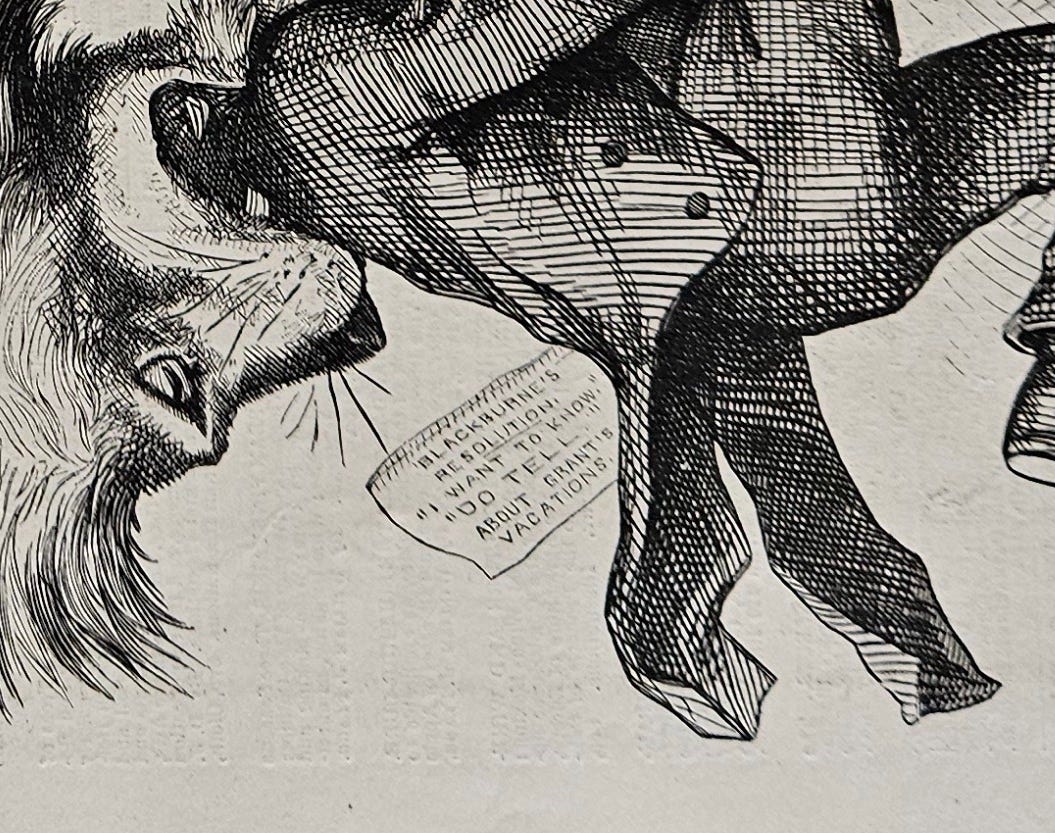"GRANT EATEN" (May 27, 1876. NAST drawing about Grant's problems in office. with a strong satiric stance on one of the many congressional investigations into the Grant Administration.
https://www.history.com/topics/us-presidents/compromise-of-1877
"THE LION (U. S. G.) NOT IN LOVE----WENT TO CLIP, BUT WAS CLIPPED." with a strong satiric stance on one of the many congressional investigations into the Grant Administration. Pro Grant content with strong Anti-investigation content as shown in scan(s). Nast was a close friend of Grant & his strong defender in these investigations.
(From InValuable website).
Thomas Nast (1840-1902) was a German-born American caricaturist and editorial cartoonist considered to be the "Father of the American Cartoon". He was the scourge of Democratic Representative "Boss" Tweed and the Tammany Hall Democratic party political machine & of the Democratic Party in general whom he considered pro-South traitors.
He was also strongly anti-Irish & anti-Catholic Church, since in the 19th century the Irish strongly supported the Democratic Party & were predominately Catholic. Nast considered the Catholic Church as a threat to American values.
According to his biographer, Fiona Deans Halloran, Nast was "intensely opposed to the encroachment of Catholic ideas into public education". Among his notable works were the creation of the modern version of Santa Claus----based on the traditional German figures of Sankt Nikolaus and Weihnachtsmann----and the political symbol of the elephant for the Republican Party. Contrary to popular belief, Nast did not create Uncle Sam----the male personification of the American people----or Columbia----the female personification of American values----or the Democratic donkey, though he did popularize these symbols through his artwork.
Nast was associated with the magazine Harper's Weekly from 1859 to 1860 and from 1862 until 1886.
It has been argued by eminent historians that as a political cartoonist, Thomas Nast wielded more influence than any other artist of the 19th century. He not only enthralled a vast audience with boldness and wit, but swayed it time and again to his personal position on the strength of his visual imagination. President Lincoln called Nast "our best recruiting sergeant" for one of his most celebrated cartoons "Compromise with the South", which was directed against those in the North who opposed the prosecution of the American Civil War, as well as, for drawing battlefields in border and southern states.
President Grant attributed his victory in 1868 to "the sword of Sheridan and the pencil of Thomas Nast." In the 1872 presidential campaign, Nast's ridicule of Horace Greeley's candidacy was especially merciless.
After Grant's victory in 1872, Mark Twain wrote the artist a letter saying: "Nast, you more than any other man have won a prodigious victory for Grant----I mean, rather, for Civilization and Progress." As a crusading civil reformer he helped destroy the corrupt "Boss" Tweed Ring that swindled NYC of millions of dollars. His impact on American public life was formidable enough to profoundly affect the outcome of every presidential election during the period 1864 to 1884.
(Small drawing detail, IN UPPER RT. )
CLOSE-UP IMAGE FLIPPED TO READ SMALL NOTE (Who was “BLACKBURNE?”).
Read about COMPROMISE OF 1877 (<https://www.history.com/topics/us-presidents/compromise-of-1877)> here:
The Democrats agreed not to block Hayes’ victory on the condition that Republicans withdraw all federal troops from the South, thus consolidating Democratic control over the region. As a result of the so-called Compromise of 1877 (or Compromise of 1876), Florida, Louisiana and South Carolina became Democratic once again, effectively bringing an end to the Reconstruction era.
By the 1870s, support was waning for the racially egalitarian policies of Reconstruction, a series of laws put in place after the Civil War to protect the rights of African Americans, especially in the South. Many southern whites had resorted to intimidation and violence to keep blacks from voting and restore white supremacy in the region.
Beginning in 1873, a series of Supreme Court decisions limited the scope of Reconstruction-era laws and federal support for the so-called Reconstruction Amendments, particularly the 14th Amendment and 15 Amendment, which gave African Americans the status of citizenship and the protection of the Constitution, including the all-important right to vote.
In addition, accusations of corruption within the administration of Ulysses S. Grant and an economic depression had heightened discontent with the Republican Party, which had been in the White House since 1861. As the 1876 presidential election approached, the Democrats chose Governor Samuel B. Tilden of New York as their candidate, while the Republicans nominated Rutherford B. Hayes, governor of Ohio. In his acceptance of the nomination, Hayes wrote that if elected, he would bring “the blessings of honest and capable local self-government” to the South–in other words, restrict federal enforcement of unpopular Reconstruction-era policies.
—————
—








I had no idea Thomas Nast was such a big deal! It makes me ponder how the Internet and Social Media have affected the ability of a single artist to have that sort of influence. It seems like now it's so much easier for people to simply withdraw into their own Social Media fortress and ignore everything/everyone else who might change or affect their views.